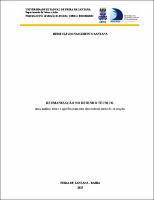| Compartilhamento |


|
Use este identificador para citar ou linkar para este item:
http://tede2.uefs.br:8080/handle/tede/1935Registro completo de metadados
| Campo DC | Valor | Idioma |
|---|---|---|
| dc.creator | Santana, Hemeclecio Nascimento | - |
| dc.creator.Lattes | http://lattes.cnpq.br/5301705500668835 | por |
| dc.contributor.advisor1 | Oliveira, Selma Soares | - |
| dc.contributor.advisor1Lattes | http://lattes.cnpq.br/0445963820054976 | por |
| dc.date.accessioned | 2025-09-17T12:22:45Z | - |
| dc.date.issued | 2025-06-30 | - |
| dc.identifier.citation | SANTANA, Hemeclecio Nascimento. Reumanização no Desenho Técnico: uma análise sobre o aperfeiçoamento dos instrumentos de execução, 2025, 127 f., Dissertação (mestrado) - Programa de Pós-Graduação em Desenho Cultura e Interatividade, Universidade Estadual de Feira de Santana, Feira de Santana. | por |
| dc.identifier.uri | http://tede2.uefs.br:8080/handle/tede/1935 | - |
| dc.description.resumo | Esta pesquisa analisa a evolução das tecnologias de Desenho Técnico nos últimos cinquenta anos e seus impactos na desumanização das representações gráficas, especialmente na formação identitária dos profissionais de Arquitetura e Engenharia. Com o avanço das ferramentas digitais, observou-se uma transição do desenho manual para o digital, o que trouxe benefícios como maior precisão, clareza e produtividade. No entanto, essa mudança também gerou um afastamento do projetista da experiência sensorial e subjetiva do desenho, provocando a perda de elementos humanizadores nas representações gráficas. O objetivo geral é compreender como essas transformações influenciam o processo criativo e o ensino do desenho técnico. Para isso, a metodologia adotada combinou revisão de literatura com análise comparativa de desenhos técnicos elaborados por três gerações de arquitetos da família Bratke, utilizando diferentes tecnologias ao longo das últimas cinco décadas. Os resultados mostram que os desenhos manuais apresentavam gestualidade, traços únicos e imperfeições que revelavam a identidade do autor e aproximavam o profissional de sua criação. Em contraste, os desenhos digitais evidenciam uma padronização crescente e ausência de marcas subjetivas, contribuindo para a desumanização do processo. A pesquisa conclui que é necessário refletir criticamente sobre o uso das tecnologias no ensino e na prática do desenho técnico, buscando um equilíbrio entre precisão e expressão. O estudo também propõe uma abordagem metodológica que pode ser aplicada a outras investigações voltadas à análise gráfica e à preservação da identidade na representação técnica. | por |
| dc.description.abstract | This research analyzes the evolution of technical drawing technologies over the past fifty years and their impacts on the dehumanization of graphic representations, especially in the identity formation of Architecture and Engineering professionals. With the advancement of digital tools, there has been a shift from manual to digital drawing, which brought benefits such as increased precision, clarity, and productivity. However, this transition also led to a detachment of the designer from the sensory and subjective experience of drawing, resulting in the loss of humanizing elements in graphic representations. The main objective is to understand how these transformations influence the creative process and the teaching of technical drawing. To this end, the adopted methodology combined a literature review with a comparative analysis of technical drawings produced by three generations of architects from the Bratke family, who used different technologies over the last five decades. The results show that manual drawings displayed gesture, unique strokes, and imperfections that revealed the author's identity and fostered a closer connection between the professional and their creation. In contrast, digital drawings demonstrate increasing standardization and a lack of subjective marks, contributing to the dehumanization of the process. The research concludes that it is necessary to critically reflect on the use of technology in the teaching and practice of technical drawing, aiming for a balance between precision and expression. The study also proposes a methodological approach that can be applied to other investigations focused on graphic analysis and the preservation of identity in technical representation. | eng |
| dc.description.provenance | Submitted by Daniela Costa (dmscosta@uefs.br) on 2025-09-17T12:22:45Z No. of bitstreams: 1 HEMECLECIO NASCIMENTO SANTANA - Dissertacao.pdf: 3819424 bytes, checksum: a32b55a693e0220d2d1a9b4f9e38c3e2 (MD5) | eng |
| dc.description.provenance | Made available in DSpace on 2025-09-17T12:22:45Z (GMT). No. of bitstreams: 1 HEMECLECIO NASCIMENTO SANTANA - Dissertacao.pdf: 3819424 bytes, checksum: a32b55a693e0220d2d1a9b4f9e38c3e2 (MD5) Previous issue date: 2025-06-30 | eng |
| dc.format | application/pdf | * |
| dc.thumbnail.url | http://tede2.uefs.br:8080/retrieve/8086/HEMECLECIO%20NASCIMENTO%20SANTANA%20-%20Dissertacao.pdf.jpg | * |
| dc.language | por | por |
| dc.publisher | Universidade Estadual de Feira de Santana | por |
| dc.publisher.department | DEPARTAMENTO DE LETRAS E ARTES | por |
| dc.publisher.country | Brasil | por |
| dc.publisher.initials | UEFS | por |
| dc.publisher.program | Mestrado Acadêmico em Desenho Cultura e Interatividade | por |
| dc.rights | Acesso Aberto | por |
| dc.subject | Desenho Técnico | por |
| dc.subject | Representação gráfica | por |
| dc.subject | Impacto tecnologico | por |
| dc.subject | Technical Drawing | eng |
| dc.subject | Graphic Representation | eng |
| dc.subject | Technological Impact | eng |
| dc.subject.cnpq | ARTES PLASTICAS::DESENHO | por |
| dc.title | Reumanização no Desenho Técnico: uma análise sobre o aperfeiçoamento dos instrumentos de execução | por |
| dc.type | Dissertação | por |
| Aparece nas coleções: | Coleção UEFS | |
Arquivos associados a este item:
| Arquivo | Descrição | Tamanho | Formato | |
|---|---|---|---|---|
| HEMECLECIO NASCIMENTO SANTANA - Dissertacao.pdf | Santana, Hemeclecio Nascimento - Dissertação | 3,73 MB | Adobe PDF |  Baixar/Abrir Pré-Visualizar |
Os itens no repositório estão protegidos por copyright, com todos os direitos reservados, salvo quando é indicado o contrário.




